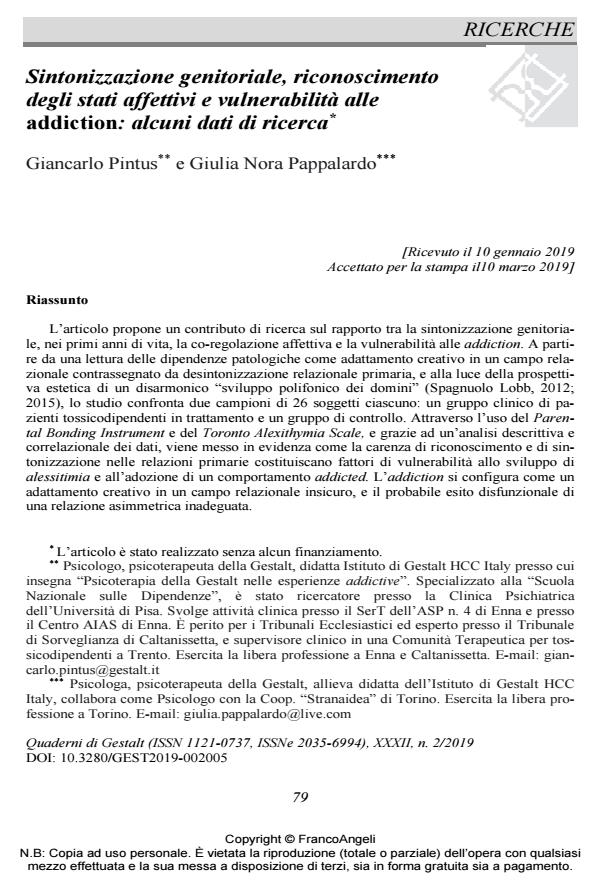Parental Tuning, Recognition of Affective States and Vulnerability to Addiction: Some Re-search Data
Journal title QUADERNI DI GESTALT
Author/s Giancarlo Pintus, Giulia Nora Pappalardo
Publishing Year 2020 Issue 2019/2
Language Italian Pages 19 P. 79-97 File size 268 KB
DOI 10.3280/GEST2019-002005
DOI is like a bar code for intellectual property: to have more infomation
click here
Below, you can see the article first page
If you want to buy this article in PDF format, you can do it, following the instructions to buy download credits

FrancoAngeli is member of Publishers International Linking Association, Inc (PILA), a not-for-profit association which run the CrossRef service enabling links to and from online scholarly content.
The article proposes a research contribution on the relationship between parental attune-ment in the first 16 years of life, affective co-regulation and vulnerability to addictions. Ac-cording to the Authors, addiction can be understood as a creative adaptation to a belonging intention never fully realized, the effort to overcome the relational void left by experiences of lack of attunement that have caused relational recognition to fail. If the background of the par-ent-child experience is too full of anxiety, or if some suffering interferes with proper attune-ment, the child is likely to develop a specific vulnerability that compromises good identifica-tion with the emotions and intention of the field. Thus, it is highly probable that, in front of excitements that are not supported and contained in the holding relationship, the child could implement processes of bodily and emotional desensitization, which is the precondition for the development of alexithymia: a creative adaptation to the perceived chaos. The aim of this study is to evaluate the correlation between compelling experience and the quality of primary rela-tionships and whether, and how, "traumatic" relational experiences work as a factor of vulner-ability to the development of an addiction. Starting from a reading of pathological dependen-cies as a creative adaptation in a relational field marked by primary relational detuning, and in the light of the aesthetic perspective of a disharmonic "polyphonic domain development" (Spagnuolo Lobb, 2012; 2015), the study compares two samples of 26 subjects included: a clinical group of drug-dependent patients in treatment and a control group. All groups of sub-jects underwent the parental bonding tool (Parker et al., 1978) and the Toronto Alexithymia Scale (Bressi et al., 1996). From the results, it emerges in the clinical group prevails a style of parenting called "control without affection", (low levels of caregiving and ligh levels of hyper-activity) both in the relationship with the mother and with the father; in the clinical group there are also significantly higher levels of alexithymia than in the control group. Thanks to the cor-relational analysis of the data, it is evident that the lack of good parent-child attunement in pri-mary relationships is considered a factor of vulnerability to the development of alexithymia and can lead to a greater predisposition to engage in addictive behaviour. The authors therefore believe that early relational failures in parental care can lead to an emotional-relational and neu-robiological background positive to a specific vulnerability in regards to addictive experiences. In this sense, the addiction takes the form of a creative adaptation in an insecure relational field, as the outcome of an inadequate asymmetrical relationship, as well as a dramatic attempt to realize a unacknowledged and non supported intentional contact in the caregiving relation-ship, which is always an intentionality of belonging. The article was produced without any funding.
Keywords: Addiction, parenting, alexithymia, relational tuning, relational intentionality.
Giancarlo Pintus, Giulia Nora Pappalardo, Sintonizzazione genitoriale, riconoscimento degli stati affettivi e vulnerabilità alle addiction: alcuni dati di ricerca in "QUADERNI DI GESTALT" 2/2019, pp 79-97, DOI: 10.3280/GEST2019-002005